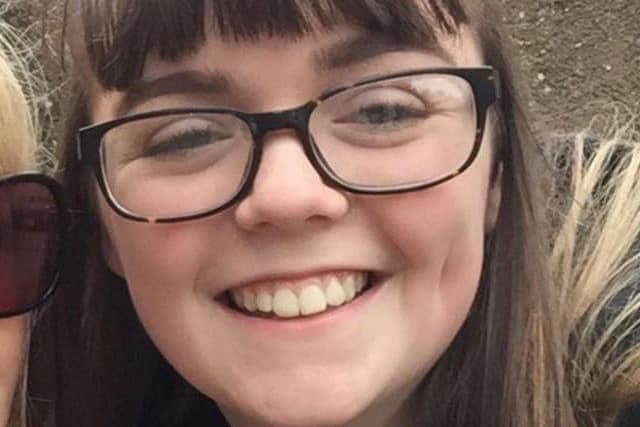Manchester Arena blast inquiry hears Georgina Callander was approximately four metres away from suicide bomber Salman Abedi
and live on Freeview channel 276
Georgina Callander, 18, and a former pupil at Bishop Rawstorne CE Academy at Croston did not arrive at a casualty clearing station on the concourse at Victoria railway station until nearly an hour after the blast at the nearby City Room foyer at the end of an Ariana Grande concert in May 2017.
The teenager’s parents, Lesley and Simon, said she “lit up the room when she walked in with her beautiful, big smile”, had “a heart as big as the moon”, was a “super-fan” of the singer and watched the performance with a friend.
Advertisement
Hide AdAdvertisement
Hide AdThe public inquiry into the bombing on May 22, which killed 22 people and injured hundreds, heard Ms Callander walked through the exit doors into the City Room shortly before the explosion at 10.31pm.


Her friend recalled Ms Callander was walking towards a merchandise stall ahead of her and turned back and smiled at her before starting to run to the stall.
Ms Callander was approximately four metres away from suicide bomber Salman Abedi at the time of detonation.
She suffered unsurvivable injuries but witnesses said she was breathing after the explosion although she was not conscious, the inquiry heard.
Advertisement
Hide AdAdvertisement
Hide AdPatrick Ennis, one of only three paramedics to enter the City Room, assessed her at 11.06pm and concluded she was a Priority 1 (P1) patient. He told the inquiry he recalled telling police at the scene she should be the “highest priority” and the next person to be moved from the foyer.
He said there were multiple P1s in the foyer as he triaged the area and there was nothing visual to identify her as the highest priority, which would “always needed to be explained”.
Pete Weatherby QC, representing Ms Callander’s father Simon, who attended Wednesday’s hearing, told Mr Ennis the family were “acutely aware” of the position he, police officers, members of the public and others were in trying to help, but pointed out that 35 minutes had passed since the explosion by the time he walked over to look at her.
The barrister added 55 minutes had passed when Ms Callander was removed from the City Room and just short of 58 minutes when she made it to the casualty clearing station where she had care from paramedics for the first time.
Advertisement
Hide AdAdvertisement
Hide AdMr Weatherby asked: “Given the fact she was your highest priority, that was an unacceptable delay, was it not?”
Mr Ennis replied: “I would agree, ideally she would have reached the casualty clearing station much sooner than that. That was my intention and I’m sorry that didn’t happen.”
Ms Callander’s mother Lesley, who had been due to collect her, was on a footbridge leading to the foyer when her daughter was carried by police officers on a makeshift stretcher, and pleaded with medics not to give up on her daughter.
The teenager was eventually placed in an ambulance at 11.39pm – an hour and eight minutes after the explosion.
Advertisement
Hide AdAdvertisement
Hide AdParamedic Adam Williams said he understood she had just gone into cardiac arrest after he arrived at Victoria station and she was not breathing.
Chest compressions were commenced and she started to breathe again, he said, before the ambulance departed for Manchester Royal Infirmary.
Mr Williams said Ms Callander went into cardiac arrest again within a minute or 90 seconds of arriving at the hospital as fellow paramedic John Buchanan, who was in the ambulance with Mrs Callander and her friend, recalled the teenager’s body was “shutting down”.
Advanced life support was provided for 30 minutes by hospital clinicians but there was no response and Ms Callander was pronounced dead at 12.05am on May 23.
Advertisement
Hide AdAdvertisement
Hide AdA post-mortem examination gave the cause of death as a head injury and a later review by two forensic pathologists concluded her injury was so severe that even with resuscitation she would not have survived.
Off-duty nurse Beth Crook, who helped clear Georgina’s airway before the ambulance crew arrived, told the inquiry: “I just want Georgina’s family to know, and anybody else who I helped that day, I’m very sorry for what happened to her but… everybody that was with them tried their hardest to make sure they were safe and secure and protected and loved in that moment. They weren’t alone.”
Inquiry chairman Sir John Saunders said the teenager was “on the threshold of her adult life, setting off on her chosen career looking after sick children, a career she was dedicated to and which she always wanted to do and no doubt would have been very good at”.
He added: “Her loss naturally gives rise to feelings of extreme sadness but also to feelings of extreme frustration at how unnecessary her dying and her death was.”
The inquiry continues on Thursday.
Advertisement
Hide AdAdvertisement
Hide AdIt is thanks to our loyal readers that we can continue to provide the trusted news, analysis and insight that matters to you. For unlimited access to our unrivalled local reporting, you can take out a subscription here and help support the work of our dedicated team of reporters.
Comment Guidelines
National World encourages reader discussion on our stories. User feedback, insights and back-and-forth exchanges add a rich layer of context to reporting. Please review our Community Guidelines before commenting.
